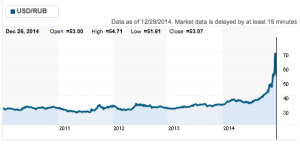 The second half of 2014 witnessed a massive depreciation in the value of the Russian Ruble, culminating in the currency briefly hitting an all-time low of Rb80 per US Dollar as recorded on 16th December – a date now being dubbed as ‘Black Tuesday.’ Since then the ruble has rebounded to trade at 50.9 on Friday, its highest level in over three weeks, before slipping again to Rb53.95 by the close. Despite the rebound, the ruble is still considerably weaker than the Rb32–37 range it was trading between during the first half of the year.
The second half of 2014 witnessed a massive depreciation in the value of the Russian Ruble, culminating in the currency briefly hitting an all-time low of Rb80 per US Dollar as recorded on 16th December – a date now being dubbed as ‘Black Tuesday.’ Since then the ruble has rebounded to trade at 50.9 on Friday, its highest level in over three weeks, before slipping again to Rb53.95 by the close. Despite the rebound, the ruble is still considerably weaker than the Rb32–37 range it was trading between during the first half of the year.
By early December, the currency had spiralled out of control. Fears were also growing regarding the effects on Russia’s economy of the falling market price of crude oil. To curb this freefall, the Central Bank of Russia (CBR) increased interest rates, hiking its main lending rate from 10.5% to 17% on Monday 15th December, which marked a total rate increase of 11.5% since the beginning of 2014. This move proved ineffective – the ruble plunged 10% on the same day and by a further 11% the following day to all-time lows, reflecting a severe lack of investor confidence in the CBR.

Economic Implications of Cheap Oil
Despite the ruble’s somewhat encouraging recovery since then, the economic outlook for the next two years remains grim, with a sharp recession and double-digit inflation expected in 2015. The OECD chief economist Catherine Mann recently stated that a deep recession is almost certain for Russia throughout 2015. Of greater concern is the lack of a visible end in sight, especially as neither Western sanctions on Russia nor tumbling oil prices show any sign of reversing.
If OPEC continues to pump high oil output levels in the face of weak oil demand in Europe, it is expected that the crude price will continue to fall to below $50/bbl. This scenario seems to be a likely one, given that key OPEC member Saudi Arabia stated on Friday that the oil cartel would have no problem maintaining current output levels even if prices were to fall to $20/bbl.
Unfortunately for Russia, where energy accounts for 25% of its GDP and 70% of its exports, this would result in substantially lower export revenues from oil production and a worsening of the trade deficit (the difference between the total value of imports and the total value of exports), which would only add to the extent of its downturn. Indeed, the CBR believes that even if oil stays at $60/bbl, Russia’s GDP could fall by 5% in 2015.
An Impending Liquidity Crisis
Western sanctions over the Ukraine political crisis have also severely hampered the Russian economy by deterring foreign investment and spurring a situation of capital flight (where a nation experiences a large-scale exit of financial assets and capital in response to political and/or economic instability). This is exacerbated by the fact that the CBR now has to manage a Russian economy in a significantly higher interest rate environment, where lending opportunities will be sparse.
Currency and interest rate volatility also damage the creditworthiness of borrowers because the risk of default on variable rate loans increases, and implies that Russia’s credit markets will dry up. This lack of liquidity, coupled with the curtailment of access to finance for banks – a result of the imposition of sanctions – means that it is highly probable that at least a handful of Russian financial institutions will default in the coming year.
In fact, last week the CBR announced it would bail out the mid-sized lender Trust Bank to the tune of USD $2.4 billion to prevent it from being the first bankruptcy casualty of the ruble crisis. With over 800 banks in Russia, however, and with many of them having weak balance sheets, bankruptcies can only deepen the recession further. One positive, however, is the fact that many banks in Russia are state-owned, implying that access to financial support might be easier for those institutions.
Ratings agency Moody’s downgraded Russia’s foreign-currency deposit ceiling last week, as well as its long-term deposit, debt and issuer ratings. In addition, Moody’s downgraded the financial strength ratings of 16 Russian financial institutions, reflecting the impact of the ruble crisis on depleting bank funding costs, asset quality and profitability. Moody’s has also forecast a 5.5% Russian GDP contraction in 2015, broadly in line with consensus, and a 3% contraction in 2016. This outlook says much about the long-term challenges of the liquidity crunch, exchange rate volatility, accelerating inflation and the low crude oil price, all of which Russia will undoubtedly – and undesirably – face in the coming year.

